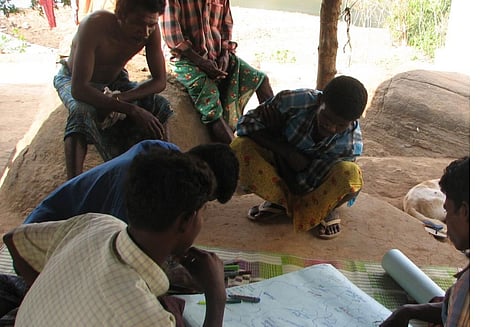

PART 3 Guardians of the Forest
# Ajayan |
The predominant Kadar tribe, native to this region, harbours deep-seated opposition to dam construction, and with good reason. Their history is marked by repeated displacement, beginning with the construction of three dams at Parambikulam, which uprooted their community. Seeking refuge in Upper and Lower Sholayar and Peringalkuthu, they once again found themselves forced to relocate when new dams emerged in these areas.
Now, with the proposal for small hydel projects, such as the one at Sholayar, history threatens to repeat itself. The project envisions redirecting post-production water through a tunnel to generate additional electricity - an intervention that, despite its seemingly minimal footprint, raises profound concerns about the tribe’s land, water rights and ecological stability.
The construction of tunnels would necessitate rock blasting, posing a severe threat to an already fragile ecosystem. The scars left by the catastrophic floods of 2018 and 2019 remain fresh, reinforcing the deep-seated apprehensions of the indigenous communities.
As part of the proposed tunnel project, trees were earmarked for felling, further exacerbating environmental concerns. In response, the tribespeople, invoking their rights under the Forest Rights Act (FRA), filed a legal challenge before Kerala High Court, where the case is currently under review.
Mohanan, head of Malakkappara village and president of the Sangham, a legally registered body comprising three representatives from each village, remains steadfast in his conviction: “As custodians of these forests, we are confident in our ability to resist any move that endangers the delicate ecological balance of our homeland.”
Mohanan remains unwavering in his conviction that forests are the very essence of life. He emphatically asserts that without forests, existence itself would be imperiled.
For the indigenous community, the forest is not merely a resource but a lifeline, intricately woven into their cultural, economic and ecological sustenance. Any developmental endeavour, be it dams or other projects, that threatens to destabilize an already fragile ecosystem will be met with uncompromising resistance, declares Geetha, another urumoopathi (village head) with resolute determination.
FRA and uprooting invasive species
The proliferation of invasive alien species has emerged as a grave ecological threat, severely compromising forest quality and diminishing the yield of non-timber forest produce. With the indigenous tribes already serving as the rightful custodians of these forests, the current endeavour is to systematically eradicate these invasive species and restore the landscape with native flora across Vazhachal and Parambikulam.
TV Sajeev, senior scientist at the Kerala Forest Research Institute, told Metro Vaartha that this initiative is crucial for the long-term sustainability of the region’s biodiversity and the livelihoods of forest-dependent communities. KFRI with the support of WWF-India introduced the indigenous communities to invasive species prevalent in their villages. Equipped with illustrated field guides, they actively participated in a mapping process to identify and plot these species. This data was later corroborated by KFRI experts.
Presently, the tribespeople are engaged in systematically eradicating these invasive plants using appropriate tools provided to them through KFRI. In tandem, seeds and saplings of native species, carefully collected, are being planted in areas cleared of these ecological threats. Tiju notes that the Mahatma Gandhi National Rural Employment Guarantee Scheme being implemented by the Athirappilly grama panchayat plays a pivotal role in facilitating and sustaining this large-scale restoration effort.
(Concluding part: A lone warrior in battle for indigenous rights)
